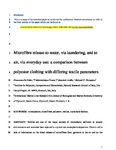Microfiber Release to Water, Via Laundering, and to Air, via Everyday Use: A Comparison between Polyester Clothing with Differing Textile Parameters
| dc.contributor.author | De Falco, F | |
| dc.contributor.author | Cocca, M | |
| dc.contributor.author | Avella, M | |
| dc.contributor.author | Thompson, RC | |
| dc.date.accessioned | 2021-08-20T13:35:29Z | |
| dc.date.available | 2021-08-20T13:35:29Z | |
| dc.date.issued | 2020-03-17 | |
| dc.identifier.issn | 0013-936X | |
| dc.identifier.issn | 1520-5851 | |
| dc.identifier.uri | http://hdl.handle.net/10026.1/17621 | |
| dc.description.abstract |
Textiles are one of the major sources of microplastic pollution to aquatic environments and have also been reported in dry and wet atmospheric deposition. There is still a lack of information on the direct release of microfibers from garments to the air and on the influence of textile characteristics including structure, type of yarn, and twist. The present study examines microfiber emissions directly to the air and to water as a consequence of laundering. Polyester garments with different textile characteristics were examined including various material compositions, fabric structure, yarn twist, fiber type, and hairiness. Scaling up our data indicates release of microfibers per person per year to the air is of a similar order of magnitude to that released to wastewater by laundering. The lowest releases to both air and water were recorded for a garment with a very compact woven structure and highly twisted yarns made of continuous filaments, compared with those with a looser structure (knitted, short staple fibers, lower twist). Our results demonstrate for the first time that direct release of microfibers from garments to air as a consequence of wear is of equal importance to releases to water. Currently there is considerable interest in interventions focused on capture from wastewater. However, our results suggest more effective interventions are likely to result from changes in textile design that could reduce emissions to both air and water. | |
| dc.format.extent | 3288-3296 | |
| dc.format.medium | Print-Electronic | |
| dc.language | en | |
| dc.language.iso | en | |
| dc.publisher | American Chemical Society (ACS) | |
| dc.subject | Clothing | |
| dc.subject | Laundering | |
| dc.subject | Plastics | |
| dc.subject | Polyesters | |
| dc.subject | Textiles | |
| dc.subject | Water | |
| dc.title | Microfiber Release to Water, Via Laundering, and to Air, via Everyday Use: A Comparison between Polyester Clothing with Differing Textile Parameters | |
| dc.type | journal-article | |
| dc.type | Article | |
| plymouth.author-url | https://www.ncbi.nlm.nih.gov/pubmed/32101431 | |
| plymouth.issue | 6 | |
| plymouth.volume | 54 | |
| plymouth.publication-status | Published | |
| plymouth.journal | Environmental Science & Technology | |
| dc.identifier.doi | 10.1021/acs.est.9b06892 | |
| plymouth.organisational-group | /Plymouth | |
| plymouth.organisational-group | /Plymouth/Faculty of Science and Engineering | |
| plymouth.organisational-group | /Plymouth/Faculty of Science and Engineering/School of Biological and Marine Sciences | |
| plymouth.organisational-group | /Plymouth/REF 2021 Researchers by UoA | |
| plymouth.organisational-group | /Plymouth/REF 2021 Researchers by UoA/UoA07 Earth Systems and Environmental Sciences | |
| plymouth.organisational-group | /Plymouth/Research Groups | |
| plymouth.organisational-group | /Plymouth/Research Groups/Marine Institute | |
| plymouth.organisational-group | /Plymouth/Users by role | |
| plymouth.organisational-group | /Plymouth/Users by role/Academics | |
| plymouth.organisational-group | /Plymouth/Users by role/Researchers in ResearchFish submission | |
| dc.publisher.place | United States | |
| dcterms.dateAccepted | 2020-02-26 | |
| dc.rights.embargodate | 2021-12-23 | |
| dc.identifier.eissn | 1520-5851 | |
| dc.rights.embargoperiod | Not known | |
| rioxxterms.versionofrecord | 10.1021/acs.est.9b06892 | |
| rioxxterms.licenseref.uri | http://www.rioxx.net/licenses/all-rights-reserved | |
| rioxxterms.licenseref.startdate | 2020-03-17 | |
| rioxxterms.type | Journal Article/Review |


